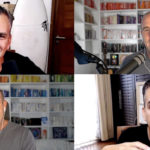The ONE Thing by Gary Keller and Jay Papasan is a bestseller in 40 languages. It deals in a distinct way with productivity, willpower and habits.
What's unusual too about the ONE Thing book is it comes from a real estate firm with its own publishing arm. Co-author Jay Papasan, who runs that arm, is our guest in this episode.
Hear Jay tell of leaving publishing to enter real estate. There he then became key to creation of books that impacted the industry. Be inspired, too, by what a book can do for a company, in this episode of SuperFastBusiness.
Podcast: Download (Duration: 42:25 — 39.0MB)
Get Notified Of Future Episodes Apple Podcasts | Spotify | Amazon Music | Android | Blubrry | Gaana | TuneIn | Deezer | Anghami | RSS | More
Episode highlights:
01:31 – Books that struck a chord
03:43 – The journey behind The ONE Thing book
05:25 – From publishing to real estate to putting out a book
09:35 – When a book makes a mark on an industry
11:46 – How does the book fit the business model?
12:54 – Bayou, puddle, ocean or well?
15:27 – What publishing can do for a business
18:41 – Commitment and the snowball effect
20:57 – The business application of The ONE Thing
22:37 – Why a database is hugely important
25:11 – The perils of reliance on someone else’s platform
29:11 – How reading can boost your chances of success
31:50 – What weekly accountability can achieve
34:53 – The 36-page version of The One Thing
38:39 – Wrapping up the episode
Achieve more of your business goals with help from James
There’s been a shift in business thinking recently, that more work doesn’t necessarily equal better results. Greg McKeown had a head start on this idea years ago with his book, Essentialism. And the concept is taken further now in The ONE Thing by Gary Keller and Jay Papasan.
In our interview with Jay, we go over some of what it takes to produce a standout book, what a book can do for a business (beyond what people normally assume), and what is contained in The ONE Thing.
When a book makes a mark on an industry
Jay Papasan was an associate editor at HarperCollins before taking a job as newsletter writer at real estate franchise company Keller Williams. He teamed up with the founder, Gary Keller, to produce five books, the first of which significantly impacted the real estate industry.
Keller Williams, when it first hired Jay, was a very small company. When Jay heard that Gary Keller wanted to write a book, he told him of his publishing background.
The first title Gary pitched to Jay was The Millionaire Real Estate Agent. They wrote it in 90 days and self-published it. It sold 100,000 copies the first year, and has sold well over a million copies to date.
They have written five books since then. Keller Williams now has its own publishing arm, and is the largest real estate firm in the world. People in the industry refer to The Millionaire Real Estate Agent as “the red book”, and competitors of Keller Williams use it to teach their own agents.
That first book was about the question, what would someone do in order to net a million dollars from a real estate sales business? To write it, they interviewed a lot of top performers, seeking an answer based on research. No one had the knowledge. So they were able to say, “If you want to build a business, instead of being a salesperson, well, we kind of wrote the book on that.”
How does the book fit the business model?
The question then becomes, how does the book fit into the business model? Because the notion many people have that you can just publish a book and live off the royalties very often just doesn’t happen.
Jay references a model from the book publishing world. You have to consider two axes: one is, how big is the market? And the other one is, how deep is the felt need? So it’s depth of need, like how big is the pain you’re solving, and how big is the market for it?
With this in mind, you have 4 categories:
1. Bayou/swamp – The need is not very deep, but the market is broad.
2. Puddle – Not a very broad market, and not a deep need.
3. Well – A small market, but the need is deep.
4. Ocean – A very broad market, and a very deep need.
The Millionaire Real Estate Agent was actually a well book. At the time of publishing it, there were only about 600 or 700,000 agents in North America. There was, however, a strongly-felt need among them to become more than just salespeople.
Jay recommends making sure you’re in either the well or the ocean category before you go to the effort of writing a book.
What publishing can do for a business
Intellectual property matters. Original intellectual property builds trust. It applies to podcasts and blogs and it applies to books, which is why James has a publishing team and Keller Williams has its publishing arm. IP is a way to build a conversation, even without you, that can lead to conversions.
“If you can create original intellectual property, that’s a way to build trust.”
The investment in IP is almost like marketing. You might not be sure of the ROI, but it is a great conversion tool. Leads are warmer and more receptive when they’ve been exposed to your material.
Commitment and the snowball effect
Doing the right thing over a long period of time is one of the concepts of The ONE Thing, and it is one of the principles of effective content marketing. The reward, says Jay, is in the people who make the longer commitments, and the audience building, and the consistency and the trust building.
Most people underestimate what it takes to actually get to that extraordinary success where the curve hits, and everything starts to gain momentum and snowball in your favor. But those are the sort of things that make for extraordinary businesses.
 James can attest to this with the results he’s gotten through podcasting, his social media videos and his own book. He’s seen the rewards as well from his commitment to his membership, and in the memberships he’s helped build. Sticking it out through tough beginnings pays off if you’re doing the right things.
James can attest to this with the results he’s gotten through podcasting, his social media videos and his own book. He’s seen the rewards as well from his commitment to his membership, and in the memberships he’s helped build. Sticking it out through tough beginnings pays off if you’re doing the right things.
Why a database is hugely important
With a coaching and a training company behind The ONE Thing, Jay takes people from reading the book to implementing its principles. Social media, he says, can be an inexpensive way to engage with a lot of people. Studying successful people, however, Jay has concluded that an email list is the asset at the foundation of their businesses.
 Your business is your database, he teaches. If someone is actually signing up to get more, they want something and they think you have it. If they have a book, they want to give people something of value. And they know exactly what’s happening – give us your email, and we’ll send this to you.It all starts with getting people into their database.
Your business is your database, he teaches. If someone is actually signing up to get more, they want something and they think you have it. If they have a book, they want to give people something of value. And they know exactly what’s happening – give us your email, and we’ll send this to you.It all starts with getting people into their database.
“If your database is on Facebook, remember they can change the rules tomorrow.”
If your database is on Facebook, Facebook could change the rules tomorrow. And it’s not your database, it’s their database. So Jay is very conscious of a database as his foundation. And for him right now, that’s an email list.
If someone doesn’t open an email from them for three months, they send a note saying, “Hey, you probably have forgotten about that you signed up for this, and we don’t want to keep occupying, so we’re going to unsubscribe. If that’s a mistake, you can sign back up here.” They don’t want a brag list, they want people that actually open and engage.
What weekly accountability can achieve
There was a lot of research behind The ONE Thing. The book mainly originated, however, from weekly coaching calls that Gary Keller had been doing for decades. At the end of each call, people would commit to three or four things they would get done before the next catch-up.
“When there’s only one thing on their list, people do it.”
Invariably, some of the three or four things would get done, but not the most important one. In frustration, Gary had attendees cut their to-do list down to one single must-do item. And to his wonder, it got done, along with other things. This was the seed of the idea for The ONE Thing.
The 36-page version of The One Thing book
The ONE Thing is a 246-page book. If it were cut down to a seventh of that, what would it absolutely have to contain?
A sense of purpose
A pyramid in the book, says Jay, illustrates something about the most productive people and businesses on Earth. Like an iceberg, they carry beneath a deep sense of purpose, a mission that they’re on. And that is their source of grit and persistence.
If you’re clear on your mission, you have a clear sense of priority, and you can say no to what doesn’t contribute to your mission.
 Says Jay, if you’re saying no to the stuff that doesn’t matter, and yes to the few things that do, by default, you’re going to be operating in your optimal productivity zone, because doing the most important thing is the definition of being productive. It’s not about how much you do, it’s about the importance and value of what you do.
Says Jay, if you’re saying no to the stuff that doesn’t matter, and yes to the few things that do, by default, you’re going to be operating in your optimal productivity zone, because doing the most important thing is the definition of being productive. It’s not about how much you do, it’s about the importance and value of what you do.
Significance before success
Jay has seen the pattern. People always want to achieve success, and then significance. If you make your success about significance, you’re a lot more likely to be successful.
“If you make your success about significance, you’re a lot more likely to be successful.”
The focusing question
What’s the one thing you can do such that by doing it, everything else is easier or necessary? Simply put, of all the things on your current to-do list, what’s the one that would be most impactful today, or this week or this month?
Time-blocking
When you know what you have to do, you need to make a reservation on your calendar for you and yourself with that task to get it done. For the most successful people on the planet, their calendars aren’t just about meeting other people. They’re really clear allocations of time to do the things that matter most.
If you just had one appointment every day, to do the one thing right that mattered most for your business, Jay guarantees, at the end of the year, you would have at least doubled it.
Start by investing 30 minutes or an hour. Call one client today, and then two tomorrow, and then two the next day, and then two the next day, then make it three, and then let it build naturally. But just show up every day and do it. And you will be so much more successful than everybody else out there.
“Clarity without execution does nothing.”
Says Jay, “I want to talk about purpose and why that underscores priority, and your productivity. I want to know the question. How do I identify my one thing? And then I’ve got to make a time commitment to go get that done, or it’s worthless. Clarity without execution does nothing.”
If you want to know more about The ONE Thing, visit the website, the1thing.com
Get insight into productivity, goals and business success inside JamesSchramko membership
Liked the show? Always be updated on our episodes – subscribe on iTunes










Leave a Reply